Introduction
The Global System for Mobile Communication (GSM) and Code Division Multiple Access (CDMA) systems are digital mobile phone services consisting of base-station antennas which communicate with the mobile phone via radio frequency (RF) transmission. In turn the base-station antenna is connected to the wired telephone system directly or via a further RF communication link.
The mobile phone system is often referred to as cellular telephone technology because the regions being covered are broken up into cells each of which has their own localized service provided by a base station antenna. Currently the network includes both digital GSM and CDMA systems. The analogue system is due to be closed down by the year 2000 and will be replaced by CDMA. This discussion will be limited to the digital system.
There are two sources of radio frequency (RF) exposure from the mobile phone system: base station antennas and the mobile phone or handset. Exposure from the antennas is continuous, irradiates the whole body and exposes an entire community in different ways according to relative positions and separation distances. Exposure from the handset to the head is more intense, is only for intermittent periods and exposure intensity and duration tends to be the user's responsibility. The RF exposure from these two sources will be dealt with separately.
Electromagnetic Radiation
The word radiation is often thought of as referring to the emanations from radioactive material and x-rays. However when scientists use the word radiation they are usually referring to non ionising radiation.
Electromagnetic non ionising radiation has electric and magnetic field components and passes through space at the speed of light - about 300,000,000 metres per second (186,000 miles per second). It is the interaction of these fields with matter that determines the effects of EMR. The study of this interaction is an important branch of physics and the knowledge gained enables us to control radiation for the benefit of mankind. The properties of EMR vary with wavelength and_or frequency (wavelength is inversely related to frequency) and thus we have radio communications, television, radar, microwave ovens, magnetic resonance imaging, toasters, cameras, lasers and X-ray machines, etc.
The Electromagnetic Spectrum
The scale at the bottom of the diagram below measures the wavelength of the
electromagnetic radiation (EMR) from long wavelength (low energy) on the left, to short
wavelength (high energy) at the right. The human eye is able to discriminate wavelength in
the visible part of the spectrum and this region has been expanded in the diagram.
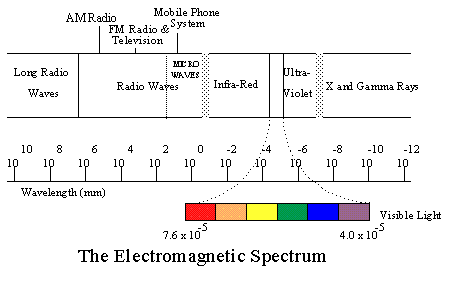
The variation in wavelength is sensed as a change in colour.
Immediately to the left of the visible spectrum is infra-red radiation which can be detected as heat although not very efficiently when compared with the ability to detect visible light. Further to the left are radio waves (including microwaves) and long radio waves which complete the low energy end of the spectrum. These radiations are unable to be perceived at normal levels.
The mobile phone system operating at about 900 MHz to 1800 MHz (megahertz) is located in a region of the spectrum that is referred to as both microwave radiation and radio frequency radiation (RFR). For the purposes of this discussion both terms will be used interchangeably.
The Mobile Phone System
Base Station Antennas
 The mobile phone
system has limitations, similar to the radio and television systems, in that the number of
frequencies available restricts the number of handsets or users within each cell. To
enable a large number of users, regions are divided up into cells each with its own set of
frequencies (GSM system). Adjacent cells have different frequencies to prevent
interference and power levels are kept to a minimum to ensure no interference with non
adjacent cells which use the same frequency. The size of the cell varies depending on the
number of users. In rural areas (and in urban areas where antenna proliferation is
constrained) which typically cover large regions, more power has to be generated to
cover the larger area. This can lead to higher radiation exposure.
The mobile phone
system has limitations, similar to the radio and television systems, in that the number of
frequencies available restricts the number of handsets or users within each cell. To
enable a large number of users, regions are divided up into cells each with its own set of
frequencies (GSM system). Adjacent cells have different frequencies to prevent
interference and power levels are kept to a minimum to ensure no interference with non
adjacent cells which use the same frequency. The size of the cell varies depending on the
number of users. In rural areas (and in urban areas where antenna proliferation is
constrained) which typically cover large regions, more power has to be generated to
cover the larger area. This can lead to higher radiation exposure.
The number of frequencies available within a cell varies from one to twelve with each
frequency able to accomadate up to eight different users. Maximum power will be
transmitted only when a frequency has all users operating at the same time. In the
diagram below the non-adjacent cells labelled A can use the same frequencies. Cells A and
B share boundaries and so must use different frequencies
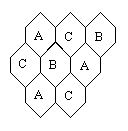
In the CDMA system all cells use the same spectrum and interference is prevented by transmitting a code which repeats at constant time intervals. These time intervals vary from one base station to another and thus enable inteference to be prevented. Transmitted power levels are kept to the minimum necessary to maintain good communications.
Antennas must be elevated and located clear of physical obstruction to ensure wide coverage and reduce the incidence of dead spots. The radiation from these antennas is beamed horizontally at the horizon with a slightly downward tilt which causes the maximum exposure to occur at distances of about 100 meters. The picture shows two sets of three high gain sector antennas - two receive and one transmit - each set of three antennas would service a single cell. The power output from an antenna will vary depending on the number of people using the facility at a given time. A typical antenna will operate at about 60 Watts. Dead spots, due to shadows caused by obstructions such as tall buildings are covered by micro cells that have an antenna power output of about 1 Watt. A base station will usually cover three cells in an arrangement similar to those labelled 'B' in the diagram below. RF exposures from CDMA base stations will be less than those experienced from GSM installations.
The siting Guidelines for base station antennas is described in Australian Standard (AS 3516.2-1998) titled Siting of Radio communications Facilities: Part 2: Guidelines for Fixed, Mobile and Broadcasting Services Operating at Frequencies above 30 MHz. This Standard deals with siting which will minimize interference between other broadcasting facilities, electrical and telephone facilities and also includes environmental considerations. The siting of mobile phone base stations is now subject to State and Territory planning laws as a result of the 1997 Telecommunications Act which came into operation on 1 July 1998.
Limitations on the RF power emitted by base station antennas are described in the Australian Standard AS/NZS 2772.1(INT) 1998 titled Radio frequency Radiation Part1: Maximum Exposure Levels - 100kHz to 300 GHz. This Standard expired on 30 April 1999 when the interim period ended: it has not been extended or replaced.
The Mobile Phone
When a GSM digital phone is transmitting, the signal is time shared with seven other users. This means that in any one second each of the eight users on the same frequency is allotted 1/8 of the time and the signal is reconstituted by the receiver to form speech. In order to limit interference between neighboring cells mobile phones are designed to use the minimum power necessary to maintain communication.
Peak power output corresponds to 2 Watts or 2000 milliwatts (mW) which averages to 250 mW of continuous power. An analogue phone (AMPS system) has peak power limited to 600mW.
For the system to function each handset within a cell is allotted a particular frequency for its use whilst in that cell and therefore the whereabouts of each mobile phone must be known. This is accomplished by having the mobile phone transmit a short signal at regular intervals to register its availability to the nearest base station. The information transmited is stored along with the phone's location on the network database. If the phone moves from one cell to another the base station with the strongest signal will maintain connection. A CDMA phone transmits with an average power of 200mW, the power varying depending on the quality of communication with the base station. Multiple users are accommadated by transmitiing the signal over a wide spectrum (spread spectrum) and applying digital codes to the data. The mobile phone uses the code to distinguish its intended message from other users. All users share the same range of radio spectrum. This technique permits more users in a given cell than for an equivelant GSM site and in general results in lower exposures from base stations than from GSM sites.
The Interaction of Radio Frequency Radiation (RFR) with Matter
Introduction
Although ionizing radiation, such as X rays and non ionising such as Radio Frequencies radiation are both part of the electromagnetic spectrum their interaction with matter is not related. Radiation such as X rays and gamma rays are able to ionize matter and this in turn causes chemical reactions. Ionizing radiation is known to be carcinogenic (cancer causing agent). Electromagnetic radiation at longer wavelengths than X rays does not have sufficient energy to cause ionization and this region of the spectrum is collectively known as non-ionizing radiation. RFR forms a part of this region of the spectrum at wavelengths longer than infra-red radiation.
When RF radiation is absorbed by matter it causes molecules to vibrate which in turn causes heating. This thermal ("cooking") effect is the sole basis (at this time) for determining the health hazard from RF exposure.
Absorption of RFR from a Mobile Phone
At distances within a wavelength from a RF transmitter is a region known as the near
field. Since mobile phone radiation has a wavelength of 30 cm at 900 MHz the users head
will be within this near field region. The head disturbs the field and alters the manner
in which RFR interacts with tissue. This interaction complicates the absorption of RF
energy within the head and makes calculations difficult. Absorptions within the head are
therefore determined experimentally or by simulation on a computer. The diagram below
shows a computer generated simulation of the distribution of RF absorption in the head
from a mobile phone held next to the left ear. The green/red region represents maximum
absorption and corresponds to a peak Specific Absorption Rate (SAR) of
2-3 W/kg (Watts per kilogram). Radiated power was simulated at 1 Watt (four times the
output of a GSM phone). A SAR of 4W/kg is associated with a 1 degree temperature rise in
humans.
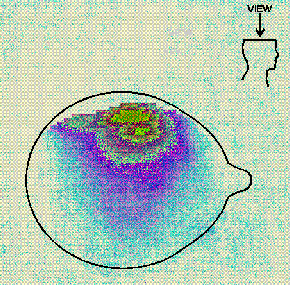
Exposure to RFR Emitted by a Base Station Antenna
As described above the RFR power emitted from a base station varies from one site to
another. The graph below shows the variation of power density levels with distance
averaged for four typical base station antennas.
The peak value of 0.1 microwatts per square centimeter compares with the Australian
Standard maximum exposure level of 200 microwatts per square centimeter.
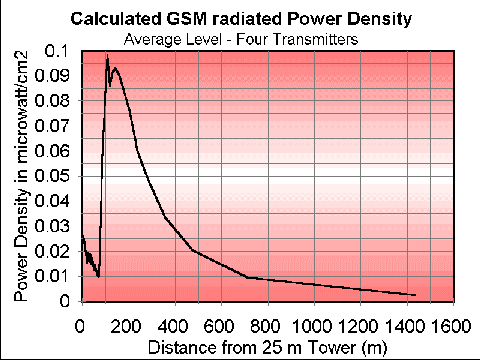
The mobile phone system operates on a number of frequencies from 900 MHz to 1800 MHz
(CDMA operates from 824-894MHz). The pie chart below shows a typical example of the
relationship of the GSM system with other broadcasters using radio frequency transmission.
Television and FM radio use frequencies of about 100MHz and AM radio uses frequencies near
1MHz. The pie chart gives the relative amount of RFR emitted by various sources measured
in Burwood a middle class suburb East of Melbourne and about 25km from the television
transmission antennas and 0.1km from the nearest base station. Measurements of power
density levels is in micro watts per square centimeter.
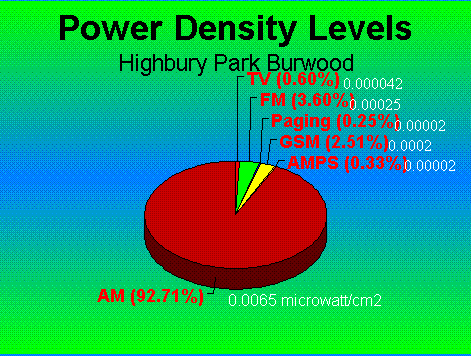
![]()
Thermal Effect
Thermal effects from RFR exposure are defined as biological effects which result from absorbed electromagnetic energy which elicits a biological response from the heat it produces. Radio frequency radiation interacts with matter by causing molecules to oscillate with the electric field. This interaction is most effective for molecules that are polar (have their own internal electric field) such as water. The water molecule loses this rotational energy via friction with other molecules and causes an increase in temperature. This effect is the basis for microwave cooking. RFR absorbed by the body occurs primarily as a result of the interaction with water.
Comparison with Heating by Conduction
In conventional cooking a gas flame or electric radiator will transfer heat into a metal pot and then into food via conduction. In this process molecules rotate and vibrate rapidly with increased temperature and pass the energy onto neighboring molecules through collisions. This is a relatively slow process relying on the thermal conductivity of the food to transfer heat into the centre. In the case of heating with RFR the energy is absorbed deeper in the object allowing rapid heating to occur. The depth of penetration of RFR in matter varies depending on the nature of the absorbing material. For example, at 1 MHz the depth of penetration (the depth at which the EMR is reduced by about a third) varies from 0.25 meters in seawater to 7.1 meters in fresh water. Thermal conduction still plays a roll in this type of heating but it is less important.
Comparison with Heating by Infra Red Radiation
The effect of heating by infra-red radiation is commonly experienced when exposed to
direct sunlight. In fact all heat received from the sun comes to us via infra-red.
Infra-red radiation interacts with matter by causing molecules to vibrate when the
radiation is absorbed. This vibrational energy is then transferred to adjacent molecules
by conduction as described above. Since infra-red radiation is readily absorbed by the
skin it does not cause internal heating (other than by conduction) as does RF radiation.
The radiated power at approximately one meter from a typical electric bar heater (albeit
infra red rather than RF radiation) is about 100,000 microwatts/cm2.
![]()
Athermal Effects
There is a considerable body of scientific literature which describes
effects of RFR in biological systems that cannot be directly attributed to heating. Low
levels of RFR have been demonstrated to cause alteration in animal behaviour, or changes
in the functioning of cell membranes.
Definition of Technical Terms
Electromagnetic Power Flux Density
The rate of flow of electromagnetic energy per unit area is used to measure the amount of radiation at a given point from a transmitting antenna. This quantity is expressed in units of watts per square meter (W/m2) or milliwatts per square cm (mW/cm2). The maximum exposure level for members of the public exposed to RFR at 900MHz is 0.2 mW/cm2.
Specific Absorption Rate
The absorption of RFR energy is measured by the quantity specific
absorption rate (SAR) in units of Watts per Kilogram (W/kg). It is defined as - the rate
at which RF energy is absorbed per unit mass of a biological body.